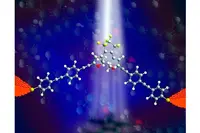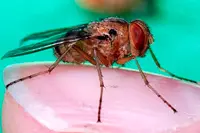Electronics News
Archive : 21 April 2015 год
 Scientists at Helmholtz-Zentrum Dresden-Rossendorf (HZDR) and the University of Konstanz are working on storing and processing information at the molecular level in order to create the smallest possible components that will combine autonomously to form a circuit.
Scientists at Helmholtz-Zentrum Dresden-Rossendorf (HZDR) and the University of Konstanz are working on storing and processing information at the molecular level in order to create the smallest possible components that will combine autonomously to form a circuit.
Scientists at the Helmholtz-Zentrum Dresden-Rossendorf (HZDR) and the University of Konstanz are working on storing and processing information at the molecular level in order to create the smallest possible components that will combine autonomously to form a circuit.
Dr Jannic Wolf, a chemist at the University of Konstanz, has discovered that a diarylethene compound is a suitable molecule. Measuring approximately 3nm, the molecule rotates very little when a point in its structure opens and there are two nanowires that can be used as contacts. The molecule is an insulator when open and becomes a conductor when closed.
Already, the team has managed to switch the current flow through the molecule with the help of light. HZDR physicist Dr Artur Erbe said: "We developed a nanotechnology that relies on extremely thin tips made of very few gold atoms. We stretch the switchable diarylethene compound between them."
When light hits the molecule, it switches from its open to its closed state, resulting in a current flowing. "For the first time, we could switch on a single contacted molecule and prove that this precise molecule becomes a conductor," Dr Erbe noted. "We have also characterised the molecular switching mechanism in detail, which is why I believe that we have succeeded in making an important step toward a genuine molecular electronic component."
One area of research focus in Dresden is self organisation. "DNA molecules are, for instance, able to arrange themselves into structures without any outside assistance. If we succeed in constructing logical switches from self organising molecules, then computers of the future will come from test tubes," Dr Erbe added.
Author
Graham Pitcher
Source: www.newelectronics.co.uk
 Staff at the University of Strathclyde have used the way a fly hears to develop what is claimed to be a revolutionary hearing aid design involving multi-directional microphone technology.
Staff at the University of Strathclyde have used the way a fly hears to develop what is claimed to be a revolutionary hearing aid design involving multi-directional microphone technology.
Staff at the University of Strathclyde have used the way a fly hears to develop what is claimed to be a revolutionary hearing aid design involving multi-directional microphone technology.
The Ormia ochracea fly, pictured, has a structure in the 2mm gap between its ears that pivots when a sound passes through it so the insect can ascertain the direction from which the sound originated.
Though advances in hearing aid design and sound analysis have advanced over the years, the microphone technology that is used has barely changed in decades.
Dr James Windmill, of the Centre for Ultrasonic Engineering at Strathclyde, said: "Currently, users can tell whether a sound source is in front or behind, but struggle to detect sounds from below or above, such as echoes in a large room.
"We aim to solve the problem using a new type of miniature directional microphone, inspired by how some insects hear sounds."
Up to 10million people in the UK are affected by hearing loss, but only 20% of these actually use hearing aids. One of the reasons for this is that hearing aids offer poor sound quality and poor performance in noisy environments.
Dr Windmill is confident the new technology will be able to effectively combat this existing design problem. "We will be able to evaluate the problems caused by the distance from which a sound emanates, for example how to separate a sound from a loud source far away, like a train or plane, from a quiet sound from nearby, like a human voice.
"The project will also investigate 3D printing techniques to optimise the hearing aid design so that it works best acoustically in conjunction with the new microphone."
Strathclyde will design, build and test the new microphones and hearing aid structures. Meanwhile, the Institute for Hearing Research at the Glasgow Royal Infirmary will test their operation, including human trials of the new designs.
Author
Tom Austin-Morgan
Source: www.newelectronics.co.uk

